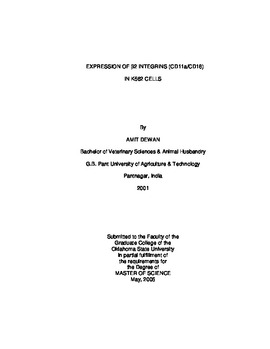| dc.contributor.advisor | Ritchey, Jerry W. | |
| dc.contributor.author | Dewan, Amit | |
| dc.date.accessioned | 2014-04-16T03:15:51Z | |
| dc.date.available | 2014-04-16T03:15:51Z | |
| dc.date.issued | 2005-05-01 | |
| dc.identifier.uri | https://hdl.handle.net/11244/9810 | |
| dc.description.abstract | Mannheimia haemolytica is the etiological agent for an economically important pneumonic disease of cattle. A critically important virulence factor for this organism is leukotoxin (LKT), an exotoxin elaborated by M. haemolytica that destroys bovine immune cells sent to protect the host. The overall goal of this project was to characterize the interaction between LKT and the putative host cell receptor bovine CD18. Toward this goal, the strategy was to establish transfected cell lines that stably express bovine CD11a/CD18, human CD11a/CD18, or inter-species hybrids (human CD11a/bovine CD18 and bovine CD11a/human CD18). Inserts were generated by PCR of either bovine or human cDNA with CD11a or CD18 specific primers that flanked the coding sequence and included restriction sites to facilitate directional cloning and subcloning. Following generation of vectors, transfections were performed in both Vero (adherent) and K562 (non-adherent) cells. Initially, Vero cells were transfected with bovine and human CD18 recombinant vectors alone. For bovine CD18, 3 out of 15 clones that survived in the GeneticinR selection medium exhibited CD18 expression as determined by immunostaining and confocal microscopy. Similarly, 5 human CD18 transfected Vero clones were isolated from the selection medium; however none of these exhibited surface CD18 expression. In fact, any CD18 expression at this step was not expected as CD18 is reportedly only expressed as a heterodimer with CD11. When tested with immunoblotting, 2 out of the 3 bovine CD18 expressing clones exhibited a band of the appropriate size for bovine CD18. Antibodies for the CD11a/CD18 heterodimer did not label CD18 expressing clones; however this might have been due to the lack of specificity. Further, bovine CD18-expressing Vero clones were not sensitive to in vitro LKT challenge. This raised the possibility that the LKT was not binding to the expressed bovine CD18 molecule or that expression with CD11 as a heterodimer was critical for LKT:receptor interactions. When K562 cells were sequentially as well as co-transfected with different combinations of bovine and human CD11a and CD18, there was usually transient expression of the species as well as inter-species heterodimers as detected by immunostaining and confocal microscopy or flow cytometry. The major drawback of conducting transient expression studies in K562 cells was generating enough cells that could be simultaneously tested for heterodimeric expression and LKT sensitivity. | |
| dc.format | application/pdf | |
| dc.language | en_US | |
| dc.publisher | Oklahoma State University | |
| dc.rights | Copyright is held by the author who has granted the Oklahoma State University Library the non-exclusive right to share this material in its institutional repository. Contact Digital Library Services at lib-dls@okstate.edu or 405-744-9161 for the permission policy on the use, reproduction or distribution of this material. | |
| dc.title | Expression of 2 Integrins (CD11a/CD18) in K562 Cells | |
| dc.type | text | |
| dc.contributor.committeeMember | Confer, Anthony W. | |
| dc.contributor.committeeMember | Saliki, Jeremiah | |
| dc.contributor.committeeMember | Wyckoff, John III | |
| osu.filename | Dewan_okstate_0664M_1370.pdf | |
| osu.college | Center for Veterinary Health Sciences | |
| osu.accesstype | Open Access | |
| dc.description.department | Veterinary Pathobiology | |
| dc.type.genre | Thesis | |
| dc.subject.keywords | 2 integrins | |
| dc.subject.keywords | cd11a/cd18 | |
| dc.subject.keywords | expression | |
| dc.subject.keywords | k562 cells | |
| dc.subject.keywords | vero cells | |
| dc.subject.keywords | mannheimia haemolytica | |
